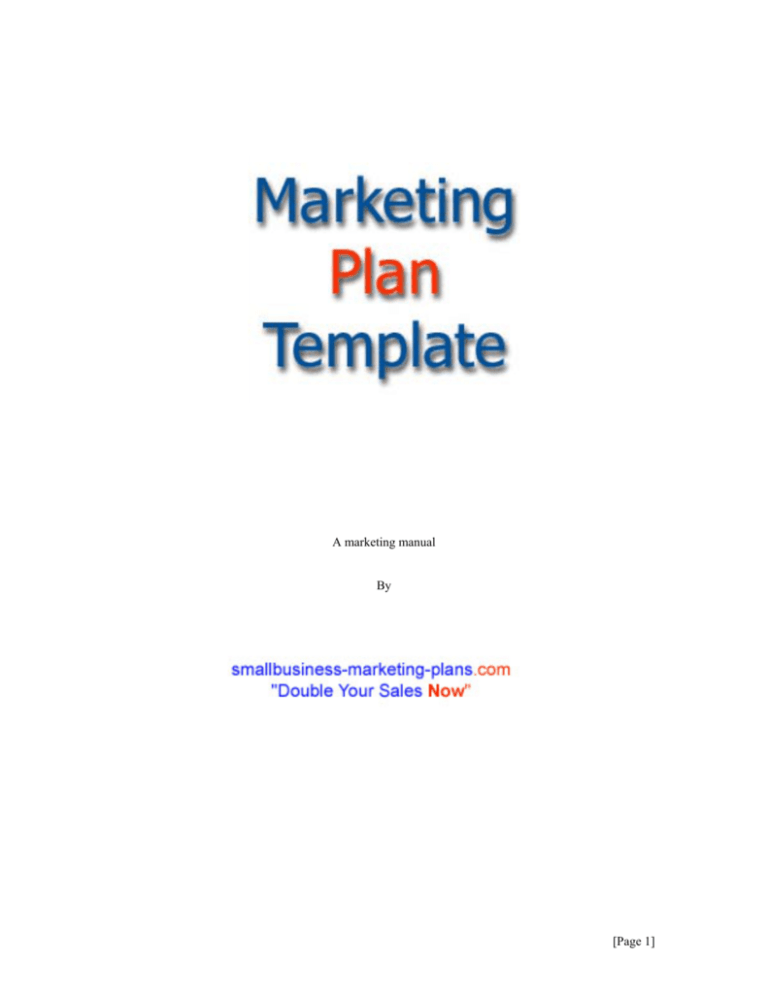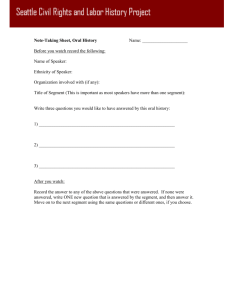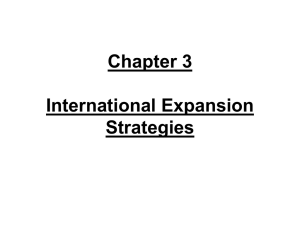
A marketing manual
By
[Page 1]
The author and publisher, smallbusiness-marketing-plan.com, have made every effort to produce a high quality, informative and
helpful book. However they make no representation or warranties of any kind with regard to the completeness or accuracy of the
contents of this book. They accept no liability of any kind for any losses or damages caused, all edged to be caused, directly or
indirectly from using the information in this book.
All product names and/ or logos are copyrights and trademarks of their respective owners.
None of these owners has authorized, sponsored, endorsed or approved of their publication.
Copyright 2004 smallbusiness-marketing-plan.com
All rights reserved worldwide
First Edition
No part of this book may be stored in a retrieval system, transmitted or reproduced in any way, including but not limited to, digital
copying and printing without the prior agreement and written permission of the publisher.
[Page 2]
Small Business Marketing Plan Template
The following forms can be used as a template for a strategic marketing plan. Please note that although this
generic template can be used for most businesses certain changes may have to be used to meet the
particular needs of your business. Please refer to Annex 1 for more plan resources and marketing plan
templates that can be used to improve your business strategic marketing plan.
We have in these several forms provided brief notes on what needs to go into the template for more
guidelines please refer to the website www.smallbusiness-marketing-plans.com
Given below is the summary of templates that can be used to present your marketing plans
Form 1: Business vision statement and mission statement
Form 2: Summary of business past performance
Form 3: Summary of financial projections
Form 4: Gap analysis for Sales (Plan to increase sales)
Form 5: Gap analysis for profit (plan to increase profit)
Form 6: SWOT analysis - Market Overview
Form 7: SWOT analysis – segment review
Form 8: List of Strategies
Form 9: Implementation of Marketing Strategies
Form 10: Strategy risk assessment
Form 11: Marketing/ sales budget
Form 12: Detailed report for market segments
Form 13: Portfolio summary
Form 14: Plan assumptions
Form 15: Financial projections – next three years
Form 16: Product group analysis
[Page 3]
Form 1: Business Vision Statement and Mission Statement
The purpose of the vision statement is to ensure that the business is targeting a (Note
Vision Statement
(Briefly describe the most desired end state for your business – the vision statement should appeal to every
stakeholder dealing with the company – these includes employees, suppliers, customers, financial
institutions etc.)
Mission Statement
Mission statement should include the following:
1. Role or contribution of the unit
2. Definition of the business – give the specific needs you satisfy or the benefits that the business
provides.
3. Distinctive competence – the competitive advantage that the business has or hopes to develop
4. Indications of future plans
[Page 4]
Form 2: Summary of business past performance
This starting section has been designed to give a bird’s eye view of the business complete marketing
activities.
In addition to quantifying performance – the chief executive of the company should give reasons for good
or bad performance.
Use ‘constant revenue’ to ensure that comparisons can be made with earlier years. ‘Constant revenue’
refers to the revenue figures after inflation has been adjusted.
2001
2002
2003
2004
Volume/ Turnover
Gross Profit (%)
Gross Profit ($’000)
Summary of factors for better or worse performance
[Page 5]
Form 3: Summary of financial projections
Its purpose is to summarize for the person reading the plan the financial results over the full year planning
period. It should be presented as a simple diagram along the following lines:
This should be followed by comments on the basis of the projects being made.
(First state what sort of turnover the business hopes to achieve and secondly state that the marketing plan
will explain how these increases will be achieved)
[Page 6]
Form 4: Gap analysis for Sales (Plan to increase sales)
1.
Quantifying the sales objective
(a) Start by plotting first the sales target you wish to achieve at the end of the planning period
(b) Next forecast the current minimum sales level
2.
Gap Analysis – Part 1
These are some ideas that are usually used to reduce the gap. The total benefit of the factors should be
plotted on the graph shown above. (The represent the cash and margin means of reducing the gap)
Productivity
Better product mix
Better customer mix
More sales calls
Better sales calls
Increase price
Reduce discounts
Charge for deliveries
Others
TOTAL
3.
Value/ Volume
Gap Analysis – Part 2
Total
Product 9
Product 8
Product 7
Product 6
Product 5
Product 4
Product 3
Product 2
Product 1
Product/ Market matrix for product penetration
(a) List out principle products on the horizontal axis and markets on the vertical axis. In each square write
the current sales and the achievable sales during the planning period.
(b) Next plot the market penetration position. This point will be the addition of all values in the right hand
half of all of all the small boxes in the Ansoff matrix.
Market 1
Market 2
Market 3
Market 4
Market 5
Market 6
Market 7
[Page 7]
4.
Gap Analysis – Part 3
Total
Product 14
Product 13
Product 12
Product 11
Product 10
(a) New products/ existing markets matrix
List out the sales you expect from new products that you will sell to existing markets.
Market 1
Market 2
Market 3
Market 4
Market 5
Market 6
Market 7
Total
Total
Product 5
Product 4
Product 3
Product 2
Product 1
(b) Existing products/ new markets matrix
List out the sales you expect from existing products that will be sold to existing markets.
Market 8
Market 9
Market 10
Market 11
Market 12
Market 13
Market 14
Total
5.
Gap Analysis – Part 4
Total
Product 14
Product 13
Product 12
Product 11
Product 10
Also sales through new products sold to new markets (diversification) should be shown below:
Market 8
Market 9
Market 10
Market 11
Market 12
Market 13
Market 14
Total
[Page 8]
Form 5: Gap analysis for profit (plan to increase profit)
6.
Quantifying the profit objective
(a) Start by plotting first the profit target you wish to achieve at the end of the planning period.
(b) Next forecast the current minimum profit level to be expected from present sales.
7.
Gap Analysis – Part 1
These are some ideas that are usually used to reduce the profit gap by increasing productivity. The total
benefit of the factors should be plotted on the graph shown above. (The represent the cash and margin
means of reducing the gap)
Productivity
Charge for deliveries
Cost reduction
More sales calls
Better sales calls
Increase price
Reduce discounts
Better product mix
Better market mix
Others (Specify)
TOTAL
8.
Profit
Gap Analysis – Part 2
Total
Product 9
Product 8
Product 7
Product 6
Product 5
Product 4
Product 3
Product 2
Product 1
Product/ Market matrix for product penetration
(c) List out principle products on the horizontal axis and markets on the vertical axis. In each square write
the current profit and the achievable profit during the planning period.
(d) Next plot the market penetration position. This point will be the addition of all values in the right hand
half of all of all the small boxes in the Ansoff matrix.
Market 1
Market 2
Market 3
Market 4
Market 5
Market 6
Market 7
[Page 9]
9.
Gap Analysis – Part 3
Total
Product 14
Product 13
Product 12
Product 11
Product 10
(c) New products/ existing markets matrix
List out the profit you expect from new products that you will sell to existing markets.
Market 1
Market 2
Market 3
Market 4
Market 5
Market 6
Market 7
Total
Total
Product 5
Product 4
Product 3
Product 2
Product 1
(d) Existing products/ new markets matrix
List out the profit you expect from existing products that will be sold to existing markets.
Market 8
Market 9
Market 10
Market 11
Market 12
Market 13
Market 14
Total
10. Gap Analysis – Part 4
Total
Product 14
Product 13
Product 12
Product 11
Product 10
Also profit through new products sold to new markets (diversification) should be shown below:
Market 8
Market 9
Market 10
Market 11
Market 12
Market 13
Market 14
Total
[Page 10]
Form 6: SWOT analysis – market overview
Market Overview
Form 7: SWOT analysis segment review
(Note: Please fill out this statement for each product/ market segment)
1.
Business description – (Give a clear and concise description for which the SWOT is being
carried out)
2.
Critical Success Factors (CSF)
Clearly identify the factors that are essential from the
customers point of view to succeed
Weightings (Give weights to
each of the CSF’s depending on
their importance)
1 to 10
1.
2.
3.
4.
5.
[Page 11]
3. Strengths/ Weakness Analysis
(Use the following grid to compare your business with those of your competitors - give a score
from 1 to 10 and then multiply by the weight)
The grid will also give you a good idea on what CSF’s you should be concentrating on to improve
your competitive position. You should also ask another person (possibly a customer) to look at
your scores to make sure that they are not biased.
Your
Business
Competitor
A
Competitor
B
Competitor
C
Competitor
D
CSF 1
CSF 2
CSF 3
CSF 4
CSF 5
4.
Opportunities/ Threats
What are the factors that directly affect your business but are beyond your control.
Opportunities
Threats
1
2
3
4
5
[Page 12]
Form 8: List of Strategies
Strategy
Cost
1.
2.
3.
4.
5.
Form 9: Implementation of Marketing Strategies
Activities, strategies, actions, responsibilities, timing, cost
Activities
Objective
Strategies
Action
Responsibility
Timing
Cost
Form 10: Strategy risk assessment
Downside risk assessment format
Description
Basis of
assumption
What should
happen to
make this
strategy
unprofitable?
Risk of such an event
occurring
High
Mediu
m
Impact if
event
occurs
Trigger
point for
action
Actual
contingency
action proposed
Low
[Page 13]
Form 11: Marketing/ Sales Budget
You can adopt the following as a tool to budget:
2002 (t-1)
2003 (t)
2004 (t+1)
Depreciation
Salaries
Postage/ telephone
Legal and professional
Training
Data Processing
Advertising
Sales Promotion
Travelling and
entertainment
Exhibitions
Printing
Meetings/ conferences
Market research
Internal costs
Other (Specify)
Total
Form 12: Detailed report for market segments
Main
competitor
Products/
markets and
current
objectives and
strategies
Business
direction
Strengths
Weakness
Competitive
position
Total
[Page 14]
Form 13: Portfolio Summary
Market Attractiveness
Business Strengths
Form 14: Plan assumptions
Assumptions:
(List all assumptions here)
[Page 15]
Form 15: Financial Projections for the next three years
Market segment sales values
Sales values
Key market
segments (List)
Last year (t-1)
Total company
market
segment sales
share
Current year (t)
Total company
market
segment sales
share
Next year (t+1)
Total company
market
segment sales
share
(t+2)
Total company
market
segment sales
share
(t+3)
Total company
market
segment sales
share
Current year (t)
Total company
market
segment sales
share
Next year (t+1)
Total company
market
segment sales
share
(t+2)
Total company
market
segment sales
share
(t+3)
Total company
market
segment sales
share
Total
Market segment gross profits
Sales values
Key market
segments (List)
Last year (t-1)
Total company
market
segment sales
share
Total
[Page 16]
Form 16: Product Group Analysis
Product
groups
Last year (t-1)
Sales
Gross
Profit
Current year (t)
%
Sales
Gross
Profit
%
Next year (t+1)
Sales
Gross
Profit
%
(t+2)
Sales
Gross
Profit
(t+3)
%
Sales
Total
[Page 17]
Gross
Profit
%









